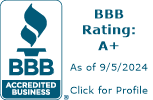Examine These Areas At Least Once A Year
It’s possible your home is full of surprises you haven’t found — yet. Unfortunately, we’re talking about the type of surprises that are taxing in time, money, and stress. The Gainesville restoration specialists with Maven Construction Group want to help you avoid any surprise with these helpful tips. Starting at the bottom and working our way up, here are nine areas of the home that should be examined each year.
Foundation
Foundations should be examined at least twice a year. And while most homes experience foundation settling over time but it’s important to pay attention to subtle and obvious signs alike. These signs include:
- Doors that jam or fail to latch;
- Open cracks in ceramic or vinyl tile;
- Wall cracks over doorways, windows, and near the seam of a wall and the ceiling; and
- Windows begin to jam or stick when opened or closed.
Check the exterior foundation for bulges or curves. These can appear in block and poured concrete foundations as the foundation shifts or surrounding soil applies uneven pressure through expansion and contraction. If you find any cracks, contact Maven Construction Group for professional leak detection residents can rely on.
Sump Pump
A sump pump is an unsung hero to many homeowners when heavy rain falls. Because Florida has a high water table, the majority of homes don’t have a basement but sump pumps are still routinely used and installed in a ground level room. But, a sump pump should be tested once a month to make sure it’s able to pump water and professionally repaired if there is an issue.
Fire Extinguishers
Fire extinguishers should be inspected each month for signs of corrosion and leakage. Make sure all safety and tamper seals are intact and the fire extinguisher can be easily accessed by everyone in the home. Newer fire extinguishers have an expiration date listed on the tank and have a pressure gauge. Older models may or may not have these features. If yours doesn’t, know that most fire extinguishers usually work for 10 years. It’s recommended to have a fire protection professional service and repair any home fire extinguishers each year.
Clothes Dryer & Dryer Ducts
Promptly removing dried clothes each time the dryer buzzes doesn’t count as inspecting the dryer. Remove the lint screen, usually located in the front of a dryer, and remove any lint build-up while checking the screen for snags or tears. A damaged screen can allow more lint than usual into the dryer vent and exhaust duct. If lint continues to build, heat from operating the dryer can ignite the lint and cause a house fire.
Damp Areas
Mold and mildew work stealthily in any damp areas of a home, such as bathrooms and the kitchen. Periodically check the base of faucets and fixtures, the caulk around bathtubs, sinks, and showers, and parts of the walls that may be blocked or obscured from direct sight. Mildew and mold removal should happen as soon as it’s found.
Insulation
The cost to heat and cool a home can take up a significant portion of any budget which makes proper insulation levels crucial. Check levels in the attic and walls with these tips.
Attic Insulation
Insulation is generally placed between the attic floor joists. Look across the joists — the insulation should be above the joists. If the level sits at or below the joists, add more insulation until the level is 3–4 inches above the floor joists. Make sure to check the level in multiple locations; it’s common to have less insulation near the eaves.
Wall Insulation
Exterior walls should be fully filled with insulation. To check these levels, remove the cover on an electrical outlet and use a flashlight to look into the space surrounding the outlet box. If the walls are adequately filled, you’ll be able to see the insulation. If not, add more until all exterior walls are full.
Air Ducts
Air ducts can be responsible for up to 40 percent of a home’s energy loss. The more energy lost, the higher your heating and cooling costs. Air ducts should be inspected by a certified heating, ventilation, and air conditioning (HVAC) technician once a year. The technician will look over the ductwork for cracks, holes, and other signs of damage and provide guidance on repairing any issues.
Attic
It’s a good idea to look around the attic for more than holiday decorations. Water from a leaking roof can damage belongings and structural surfaces, such as load-bearing joists. In addition, small animals such as raccoons and squirrels are notorious for damaging roofs to the point they’re able to enter the attic. Common signs animals have moved into the attic include:
- Chew marks and damaged property;
- Droppings;
- Old food scraps;
- Nests and nesting materials; and
- Sightings.
Roof
The roof is the last place most homeowners want a surprise. Avoid the surprise of expensive repairs — or full replacement — by occasionally checking the roof for:
- A build-up of leaves in one or multiple areas;
- Buckled, curled, or missing shingles;
- Granule loss on shingles; and
- Sagging or uneven surface plane.
An intact and fully functional roof is the first line of defense against damage that can affect the rest of the home. If you find any issue with the roof, call the Gainesville contractors with Maven Construction Group for fast and reliable roof repairs. From unabated mold growing behind a wall to repairing animal-related roof damage, we have the skills and know-how for any property damage repair. Our team of licensed professionals is available around-the-clock to help restore your peace of mind. Call us today.


